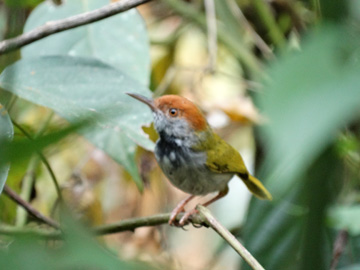The return of the Indian Warbler
-Can we save its habitat?
-S.Ananthanarayanan
The large billed reed warbler, or Indian warbler, has brought focus on conservation of wetlands, says S.Ananthanarayanan.
A specimen discovered in Thailand has shown that this bird, so far thought to be extinct, is still breeding - and the search for larger populations has started.
A century ago
Acrocephalus Orinus belongs to the genus Acrocephalus, which means ‘flat headed’. This family is part of the great clan of ‘sparrow-like’ or perching
or song-birds, and is insect-eating and short distance migratory and is associated with marshes or wetlands.
The species known as the Indian warbler was last seen in the Sutlej valley of Himachal Pradesh in India, in 1867. The specimen is not well preserved and there has always
been a doubt – was it a separate species or just a variety of 2 similar birds, the clamorous reed warbler or Blythe’s reed warbler. It was only recently that DNA tests confirmed that it was a separate species.
In March 2006, ornithologist Philip Round, of Mahido University, Thailand, was banding birds at a wastewater treatment centre near Bangkok. Banding is
to put a light metallic ring, with a unique number, around a bird’s leg. 
The bird has to be captured and the ring is placed with great care and skill, so that the bird is not traumatized. But the bird can then be monitored, by the same team or with the help
of teams the world over.
 Migration and breeding habits, life spans and population estimates then become possible.
Migration and breeding habits, life spans and population estimates then become possible.
So Philip Round discovered this bird which he immediately recognized as not the usual ones he was banding but a specimen of the long extinct large billed reed warbler! He had to be sure, of
course. He took many photographs and also collected 2 feathers for DNA analysis. Analysis has now proved that the bird was indeed the same as spotted in Himachal Pradesh 140 years ago.
Ornithologists in India and elsewhere are excited and eager to discover where larger populations are roosting and whether they are threatened.
The habitats
The genus inhabits marshes and wetlands. The recent specimen was found in the water laden inner gulf of Thailand. “This shows how important it is preserve our own wetlands and save the remarkable
biodiversity they support”, says Dr Rahmani, Director of Bombay Natural History Society.
India has an estimated 3.5 million hectares of wetlands.
The area of the whole Mumbai Metropolitan Region is 4,35,500 hectares. So the wetlands we have are about 8 times the size of Greater Mumbai. But these are fast disappearing as adjoining urbanization and coastal development or reclamation gobble them
up.
The wealth of wetland that we have may still throw up communities of our long lost warbler. We cannot say how the Indian warbler disappeared from India and how it turned up in far off Thailand.
While we now look for plucky little bird in places where it may be breeding, we must also make sure that such places continue to exist for this and other species.
For what our wetlands preserve are not just rare species of birds – they also host invaluable insect and plant varieties that must have marshes or bags to survive. Wetlands are then resources to guard and nurture, rather
than exploit for only building highways and residential complexes. If we destroy our environment, the cities that we build may not be worth living in.
[The writer may be contacted at
simplescience@gmail.com]
P.S
We have a photograph of “Warbler on a lemon tree” at the following link at http://www.wildscapes.net.
Is it a reed warbler or Blythe’s warbler? Can anyone respond?
http://www.wildscapes.net/ImageList.aspx?t=d&id=6785529